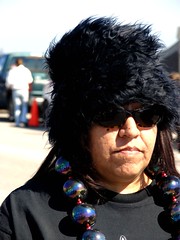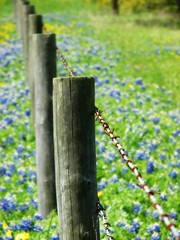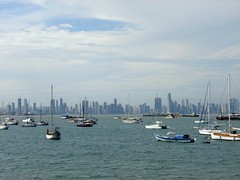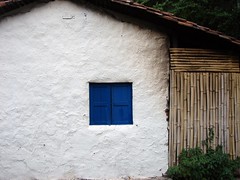As I browse through my blog, I can’t help but notice how often rice seems to come up. I really can’t help it, I have a love affair with that little grain. My only hope is that I offer some variety for you. That said, this is a rice post. Yep. Mas arroz.
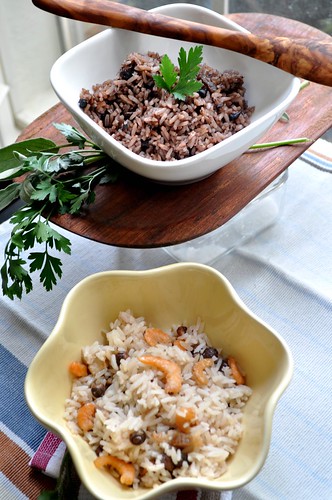
In Panama, we prepare rice in many different ways; sometimes with coconut milk, or various beans and peas. Anything you want, really. Two of my favorites are Arroz con Frijoles Negros (rice with black beans) and Arroz con Camarones Secos (rice with dried shrimp).
They’re both easy to make and follow the same process as the recipe for Arroz con Guandú. For the black beans, I used dried beans and cooked them in the coconut milk, as detailed in the recipe below, but you can use canned beans . For the one with the dried shrimp and guandú, I cooked both of those in the coconut milk first, then followed the recipe.
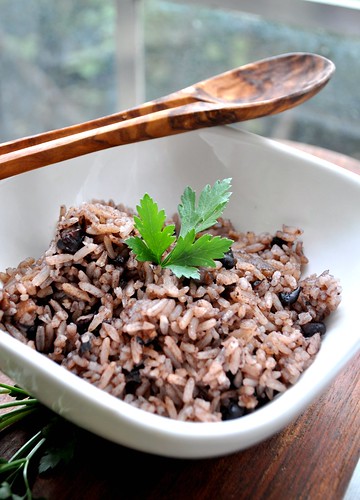
For the Arroz con Coco y Frijoles Negros (Black beans & rice)
2 cps rice
1/2 cp dry black beans
2 cps coconut milk
3 cps water
1/3 cp salt pork or bacon
1 tbsp vegetable oil

For the Arroz con Camaroncitos Secos y Guandú (Rice w/dried shrimp & pigeon peas)
2 cps rice
1 cp frozen guandú (pigeon peas)
1/2 cp dried shrimp
2 cps coconut milk
3 cps water
1/3 cp salt pork or bacon
1 tbsp vegetable oil
Method for both versions:
In a pot with a tight-fitting lid, brown the salt pork/bacon rendering some of its fat. Add the guandúes (pigeon peas), coconut milk. Bring it to a boil, then reduce the heat until it simmers. Cook it until the peas are tender, about 40 minutes. Strain the liquid and measure, add enough water to make 3-1/3 cps of liquid, set aside.
This recipe uses the frozen peas, however, if you are using the canned variety, just skip the step above. Instead, drain, rinse and strain the beans, then add coconut milk and water to measure 3-1/3 cups. Fry the salt pork or bacon just before adding the rinsed rice.
Add oil to the pan with the peas, rinse the rice and add it to the pot stirring all the ingredients. Add the liquid, check the salt, stir this well. Make sure you remove any drippings that may have been stuck to the bottom of the pan. Bring it to a slow boil; once the liquid boils do not stir it again. Keep the temperature on medium high.
Once the liquid is almost completely evaporated, bring the temperature to low and cover with the lid. Allow to steam undisturbed for 40 minutes. When you remove the lid, all the peas will be at the top, go ahead and stir them into the rice. You’re done!

Note: The flavor of the coconut milk will intensify with time. You can cook the peas a day ahead to allow the flavors to meld together.

This is a recipe I found in Jorge Jurado’s cookbook, Sabores de Panamá. I should tell you it isn’t a ‘traditional’ Panamanian dish, but rather an interpretation by this talented chef utilizing ingredients commonly found in Panama. His recipe called for beef shanks, but I had just picked up some short ribs and decided to use them instead. It turned out beautifully.
The intense combination of spices, together with the deep and rich color of the final dish made this reminiscent of Mexican mole. I can’t really think of a traditional Panamanian dish that is even remotely similar to mole, but this is a rocking interpretation!
Costillas Braseadas con Cafe, Chocolate y Anis Estrellado (Coffee, chocolate and anise braised short ribs)
Marinade – a day ahead
2-1/2 lbs short ribs
1/2 bottle red wine (one you would drink)
3 garlic cloves, diced
1 tbsp instant coffee
2 carrots, sliced
1 bay leaf
12 peppercorns
2 star anise pods
2 tbsps olive oil
1 tbsp salt
Combine all the ingredients in a ziploc bag and allow the ribs to marinate overnight or, at least for a few hours. Turn the ribs occasionally.

Braising – day of
1-1/2 onions, chopped
4 garlic cloves, chopped
Marinated ribs and the carrots
Extra virgin olive oil
Approx 2 cps broth (chicken/beef/veg)
1 tbsp sugar
1 oz bittersweet chocolate
Salt to taste
Remove the ribs from the marinade and pat dry with a paper towel. Meanwhile, heat a Dutch oven to medium-high and add the olive oil. Brown the dry ribs on all sides, remove from the pan and set aside.
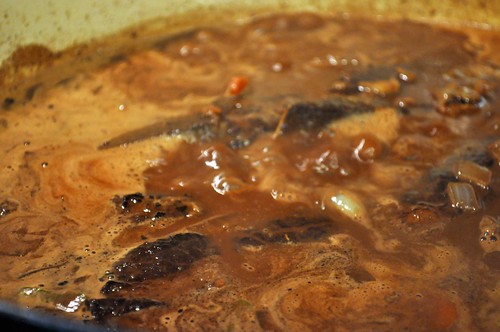
Drain the excess fat, leaving about 2 tbsp of oil/fat in the pan. Add the onions, garlic and carrots and allow to cook until they begin to caramelize. Return the ribs to the pan and add the marinade liquid, broth, sugar and chocolate.
There should be enough liquid for the ribs to be completely submerged. Bring it to a boil, then reduce the temperature to low to allow for a slow simmer. This will continue to simmer for about 2 hours, until the meat is tender and falling off the bone.

I, of course, served it over rice. I love rice, sue me! I think it would be really nice with roasted veggies too, though. For more food porn, click here.

Cookingly yours,
Anamaris
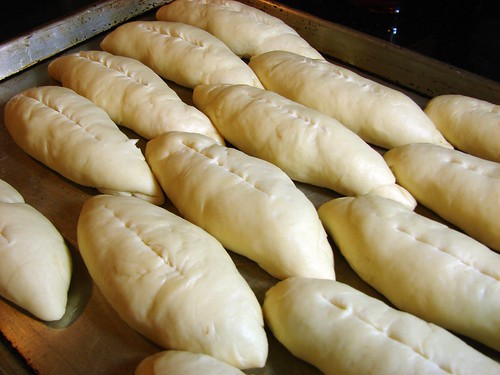
I’ve always found that to be an odd expression. The phrase itself sounds innocuous to me, but the meaning behind it makes sense. To share, to open one’s home and/or heart to another, to be welcoming. Philosophically, the idea of breaking bread is a great one. In reality, the idea of having to share my bread with someone, elicits murderous thoughts. No. Really. Don’t touch my bread!
Luckily, when I bake bread, the recipe results in enough of it that I’m able to, even if begrudgingly, share it with one or two people. Tops. You get the picture. So, a few weeks ago I made some bread. Panamanian bread, something we call Pan Micha.
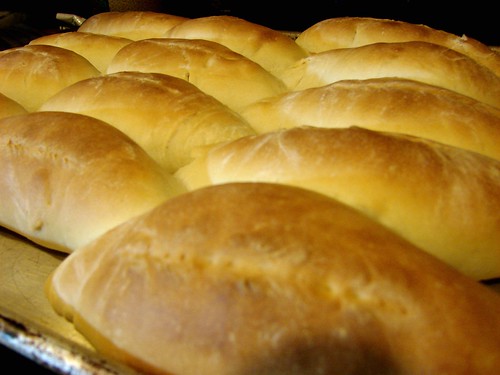
Rumor has it, this recipe was brought to my homeland by the French when they attempted building the Canal. I have no verification for that story, but I do recognize some similarities with French miche bread. Thin, golden crust and soft, light inside. What I do know for sure, if that you will find michitas anywhere there is a bakery in Panama.
I remember walking to school and stopping by the corner bakery–the aroma of freshly baked bread wafting in the air–and ordering ‘una michita con queso blanco y mantequilla‘ (a buttered michita stuffed with white cheese). Aaaaah, the bread would still be warm, the butter and local cheese melting into the center. Heavenly.
I found a recipe for it here, so I won’t retype it, just follow the link. What I want to tell you about, is how we ate them, after all, eating them is the best part.
You know I’m a traditionalist, so mine had butter and Queso Fresco. Nothing else needed. I did toast them a bit.
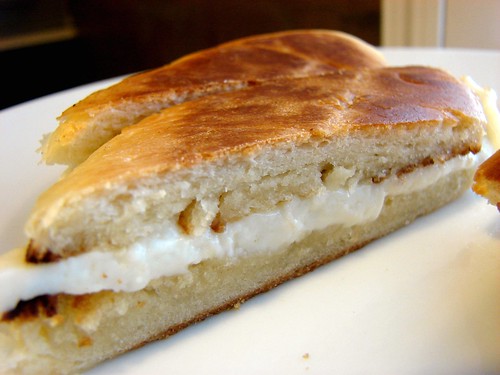
The Hubbz is a different story. He’s a man of excess, so he added some roast beef we had in the fridge. In Panama, we would’ve used ham or chorizo.
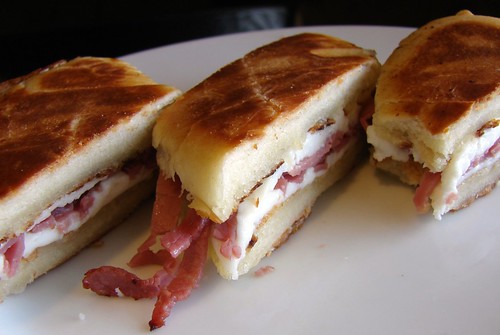
The bread was good, but not as light and airy as I remember michitas being, my quest for the perfect recipe continues.
Cookingly yours,
Anamaris
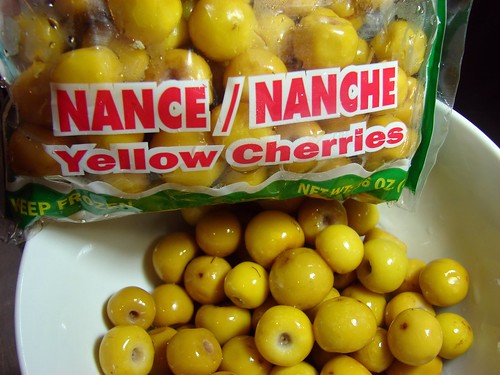
I’m not one to indulge in desserts too often, my sweet tooth is… lacking, but Flan is one of the few desserts I can’t keep my hands away from. Which means, I make it as infrequently as possible to keep that heart attack at bay.
I’m always reading about variations to flan, adding chocolate, pumpkin, coconut, it goes on and on. So, I thought of trying my own little tropical variation: Nance.
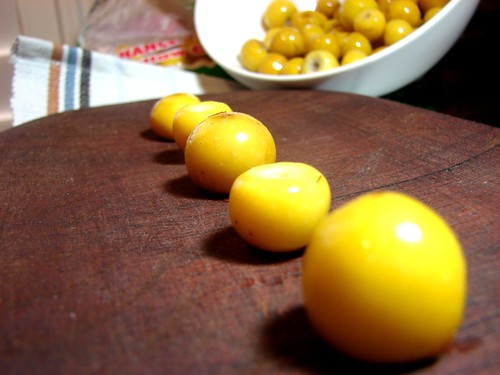
This is a very interesting little fruit, and it IS little, anywhere between the size of a blueberry and a cherry. In fact, they are known as yellow cherries in English. The fruit has some fat and is tart and becomes sweeter after picking. It grows on a tree and when they’re ready, they fall to the ground, collected, rinsed and thrown in a bottle with water for a few days. This allows them to ripen fully and develop its sweetness.
In order to get the pulp, you either have to use your hands and squish them or put them in the blender, liquid and all, and pulse them a few times to loosen the pulp. In this case, since the nance was sold in the frozen section of my grocers’, I thawed them and whirled them about in the blender with enough water to keep them moving. Strain and you’re ready to make a chicha–Panama’s pumped up fruit drinks, pesada or this to-die-for flan.
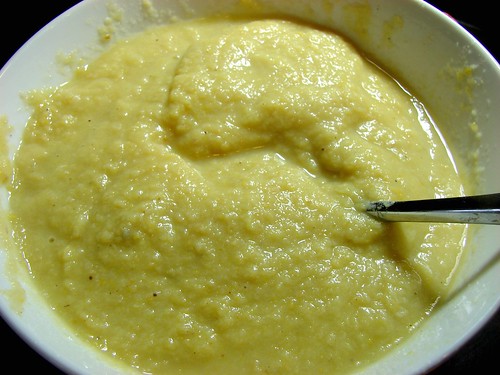
Flan de Nance
For the caramel sauce:
1-1/4 cp sugar
For the flan:
6 whole eggs
4 oz cream cheese
1-1/2 cps nance pulp
1/2 tsp almond extract
1 tsp vanilla extract
1/2 cp granulated (white) sugar
1/4 tsp sea salt (bit less if using regular salt)
1-1/2 cps whole milk
Preheat oven to 350°. Prepare a Bain-Marie: you will need a baking pan that is large enough to hold the dish you’re baking the flan in. Add hot water to the large pan and place in the oven.
To make the caramel, following the directions I gave you before for a cheese flan; here’s the link.
Making the flan: Put all the ingredients except for the milk in a blender glass and whisk until smooth. To avoid foaming the eggs, do this by pulsating instead of letting the blender go for a long time. It shouldn’t take more than 5-6 pulses.
In the meantime, use the same saucepan you used to make caramel to scald the milk. There will probably be some caramel stuck to the pot. That’s fine, just add the milk and simmer until you see bubbles beginning to form around the edges. Turn off and remove from the heat.
You will now incorporate the hot milk into the egg mixture, because the milk is pretty hot, start the blender on low and slowly drizzle in the milk/sugar mix. As soon as all the milk is added, turn off the blender. Pour the custard into the carameled baking dish. Place the dish with the custard into the pan with water.
If you bake it in a 9-inch dish, it will probably be in the oven for close to 45 minutes. You’ll know it is ready when the top is golden and it begins to separate from the sides, but there’s still a jiggle at the center. Remove from the oven and allow it to cool at room temperature for about 30 minutes, then put it in the fridge to cool it all the way through.
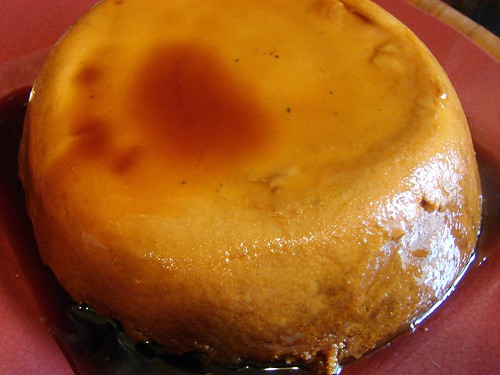
When you’re ready to serve, run a table knife around the edge to help loosen the cooled flan. Then invert it onto your serving dish. Make sure you invert over your sink, you’ll be amazed at how much of that caramel melts away onto your serving dish and continues running down your arm and on the clean floors.
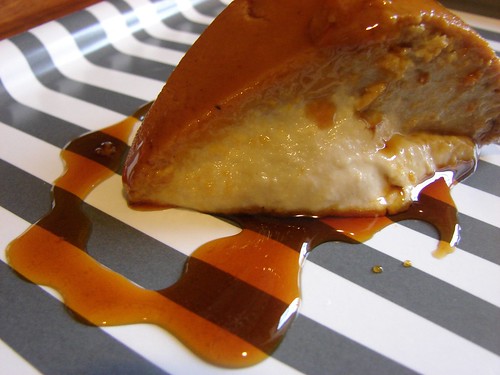
Cookingly yours,
Anamaris

I think I’ve hinted at the fact that Panama is a big seafood country. I may have also shared that we love to party. Overindulgence is quite common to us. When it happens, you hear of various remedies and traditions to cure a persistent hangover. One such remedy: Levanta muerto (raise the dead).
I’m uncertain where the restorative quality of a caldillo de mariscos comes from, or if they are real. What I do know is that it makes for excellent cold weather, hot weather, bad mood, happy mood and comfort food food.

I love seafood soups, but I wanted this broth to be light and filled with the flavors from the sea without being too fishy. So when I went to my fish market, I picked up some mild fish and asked for the carcass to be bagged separately. I then used it to make a deliciously flavored broth.

*To make the broth, I added the fish carcass, shrimp peels (no heads), 1/2 an onion, a few garlic cloves, carrots and celery to a generous pot of water that was seasoned with salt & pepper. I allowed it to simmer for a few minutes, strained and reserved the broth. Here’s how it comes together:
Caldillo de Mariscos (Seafood soup)
Seafood broth*
Clams, scrubbed
Fish (red fish, tilapia or similar), cubed
Shrimp, peeled & deveined
Culantro leaves
Fresh thyme
Yuca, peeled & cubed
Sea salt & pepper
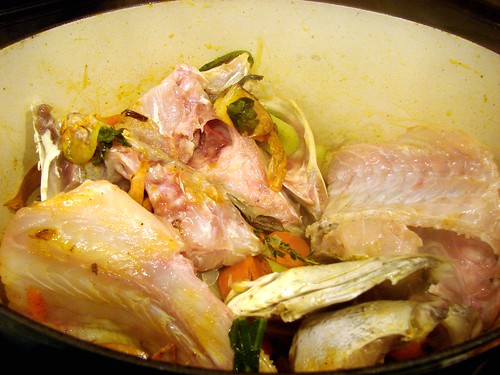
After straining the broth, I returned it to the pot, added the pieces of yuca, chopped culantro leaves (you can substitute with cilantro), a bit of finely chopped thyme, adjust the seasoning as needed. Allow it to cook until the yuca is fork-tender.
While the yuca is cooking, I seasoned the fish and shrimp with 1 tsp of Jugo Maggi (substitute with Worcestershire), then reduced the temperature to bring the broth to a slow simmer and added the fish, shrimp and clams. Allow it to simmer for about 5 minutes, just until the clams open up. Serve with white rice or crusty bread.

Want to see more food porn? Follow this link. Yeah, baby!
Cookingly yours,
Anamaris
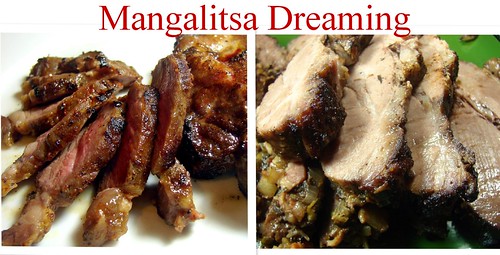
Just before Xmas one of my recipes was chosen by the folks at Marx Foods as their favorite use of cured Mangalitsa ham. To my surprise, they sent me more Mangalitsa goodness! Only, this time, it was a fresh, not cured, piece of meat. A neck roll, to be precise. This was a gift from Marx Foods and Heath Putnam Farms (they raise the piggies).

After some research, I learned that this cut is known as Secreto (secret) in Spain because it is the butchers’ best kept secret and I can understand why they keep this cut to themselves. Per Heath, this cut is known as pork collar or coppa and it is all the rage at the fancy eateries these days. He suggested preparing the roll in a couple different ways. First, I should slice a few pieces and sear them in a pan, then roast the rest. I listened and took his advice to heart; boy am I glad I did.
Since it arrived just around the holidays, my intention was to prepare and share with you another dish rooted in my Panamanian heritage , but, alas! I was so busy towards the end of the year, I never got around to posting it, though I did cook and eat it. Oh yes we did! I kept thinking about lomo relleno (stuffed loin), which is a dish typically served around the holidays. It can be beef or pork loin and it is generally stuffed with carrots, olives, raisins and many variations after that. Let’s talk pig!
Stuffed Mangalitsa Pork Collar
I wanted to make sure the meat itself was seasoned, so I made a nice rub for it. I combined Spanish paprika, pureed garlic, sea salt and black pepper with a bit of extra virgin olive oil and rubbed onto the pork collar, allowing it to marinate for a few hours.
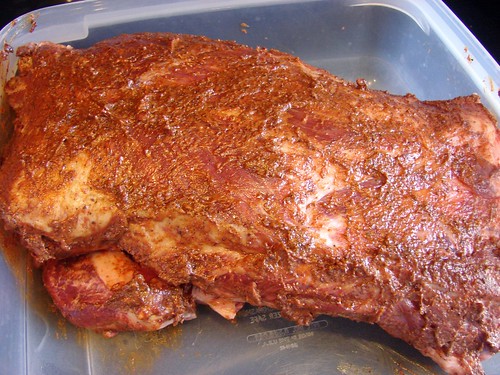
For the stuffing I chopped and rendered the fat out of some bacon, then cooked in some chopped onions, garlic, cilantro and prunes. I did allow this to cool completely before stuffing the pork. I didn’t go fancy butterflying route, instead, I simply sliced the pork collar, just shy of about an inch from the opposite end and piled it with the stuffing*.

A little twine helped keep everything even and in place for searing and roasting. You can opt-out of pan searing and simply cook it at 450° for the first 15 minutes, then lowering the temperature to 300° for the remainder of the roasting time.
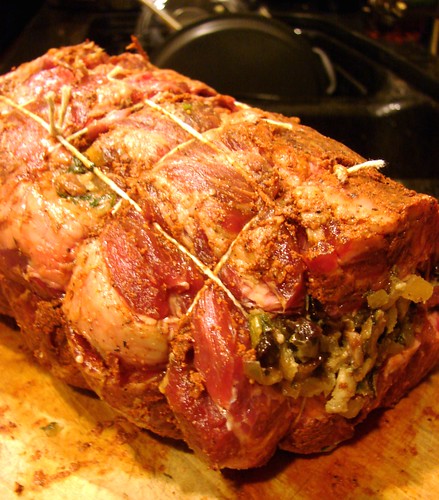
I placed it on a roasting rack with some carrots, onions and garlic strewn about the bottom of the pan. This was a 4-lb piece of meat an it roasted for about 3 hours or so, until the thermometer read 145°. I then removed it from the oven and allowed it to rest for about 15 minutes covered with foil. Believe me, we had a REALLY tough time staying away from it that long.
*Following Heath’s suggestion, and to keep us at bay while this baby roasted, I sliced off a few pieces of the collar before I made the cut for the stuffing. I heated a saute pan and added just a dab of olive oil and seared those little collar cutlets, they were about 1/2-inch thick and cooked for 2 minutes or so on each side, we still wanted them to be pink. That’s how we like our piggy. And…Oh.eM.Gee!!! We thought we’d died and gone to heaven.

Let me just try to explain something about Mangalitsa pork. It is obnoxiously delicious! I mean, I just know those little pigs trot around the pen mocking the other pigs and telling them how much better tasting they are. And you know what? THEY ARE!!! The Hubbz said this was better than beef tenderloin, yep. THAT good. The fat in the Mangalitsa is almost creamy buttery. And the meat has a slight gamey sweetness to it. I don’t know what to say or think about it, all I know is this is some really good sh#t!
Back to the roast. Once it rested and all the juices had redistributed around, we snipped off the twine and began slicing the roast.

Undoubtedly, the prunes added a delicious sweetness to the meat, just a hint, don’t worry. We feasted on this roast for a couple of days. By the time we were down to just a few bits and ends, I pan fried them to get a bit of a crust on the meat and used it to topped toasts points that had been toasted with olive oil and gotten a light spread of a fig & olive tapennade. JOOOOOOOOOYYYYY!!!! Sorry, no pictures of that madness.
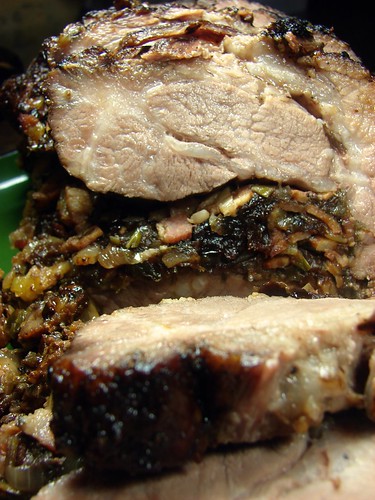
I will admit that we are completely in love with Mangalitsa and with the Secreto cut. I also have to admit this will be one of those things we purchase once a year for VERY special occasions, but purchase it we will! I’d like to thank Marx Foods and Heath Putnam Farms again for such a generous and DELICIOUS treat. You can see all the porky shots here.
Mangalitsa longingly yours,
Anamaris

This is one of two dishes I prepared to participate in Foodalogue’s Culinary Tour, this time visiting my stomping grounds, Panama! This dish came to be as a result of a ‘What’s in the Bag‘ challenge posed by my dear Hubbz. He went to the store and brought everything but the butcher’s block, which I then had to incorporate into a Latin meal.
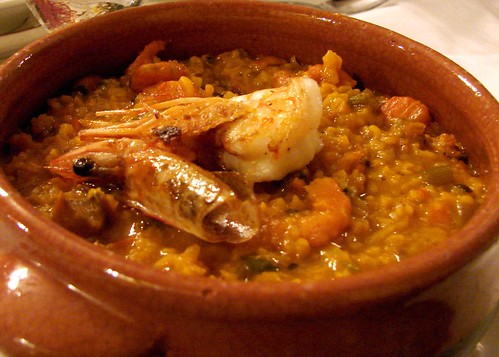
Seafood Guacho at Las Tinajas in Panama
Guacho (pronounced Wah-cho) is a popular Panamanian specialty; a slightly soupy rice dish, similar to an Italian risotto or a Puerto rican asopao. Unlike risotto, guacho is made from regular, long grain white rice that is soaked in water for a bit before it is sautéed and simmered in the cooking liquid of choice. The dish is then flavored and augmented with an array of local ingredients; there’s always some sort of meat or protein from pork, chicken, cured pig’s tails, or seafood, in addition to various beans and roots such as yuca and otoe.
Different from the way I’ve usually explained how to cook rice, the rice in guacho wants for more liquid and a longer cooking time, this allows for the rice starches to develop into a creamy, rich frenzy. I pretty much stuck to the traditional elements of the dish, only straying away in the preparation of the sofrito and by adding mushrooms to the rice itself.
Panamanian sofrito is generally made with onions, bell peppers, tomatoes, garlic and a few other aromatics, this time I included dried chile ancho and guajillos. But enough chatter, let’s cook!

Guacho de Mariscos y Hongos (Seafood & Mushroom Guacho)
6-8 servings
For the guacho:
2 cps long grain rice, soaked
Water
1/2 cp bacon, chopped
Extra virgin olive oil
1 cp mushrooms, diced
1/2 cp shallots, diced
About 8 cps seafood broth
1 cp shrimp, peeled & deveined
1 cp scallops
Sea salt
5 tbsps chile puree
2 cps sofrito
For the sofrito:
2 tbsp extra virgin olive oil
1 cp yellow onions, finely chopped
1 clove garlic, crushed
3 green onion sprigs, finely chopped
3 ripe tomatoes, finely diced
6 tbsps chile puree
Sea salt and a pinch of sugar
In a medium pan heat the oil and add the onions, cook them until soften before adding the garlic and green onions. Then add the tomatoes, 1/2 cp water and chile puree, lower the temperature and allow it to simmer for about 20 minutes. Keep warm.

For the seafood broth: I used the skins from the shrimp, bringing them to a simmer with plenty of water, 1 clove garlic, one of the dry ancho chilies, cilantro (culantro, if you can find it), 1 carrot, salt & pepper. Strain and set aside.
For the chile puree: Rinse and seed the chilies–remember Panamanian food is not typically spicy hot. Put 2 ancho and 1 guajillo chilies in a small pot with 2 cps water, 1 clove garlic, a pinch of salt and simmer for about 10 minutes until the chilies soften. Allow it to cool before running it through the blender. Set aside.
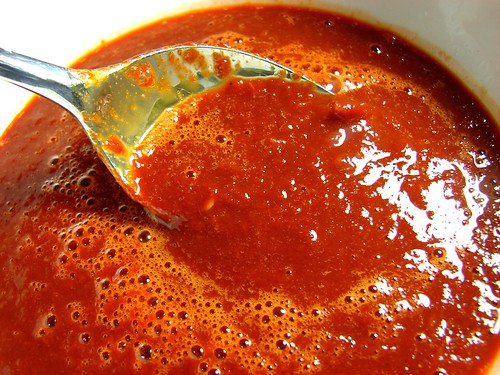
For plating: Reserve a few shrimp and scallops to place over the finished dish.
Preparation – Guacho:
Rinse the rice, then add enough cool water to cover it and allow it to soak for at least 20 minutes and up to 1 hour. In a large pan, render the fat from the bacon, but don’t crisp it. Add the onions and allow to cook until they begin to soften. Then add the mushrooms and cook for about 3 minutes.
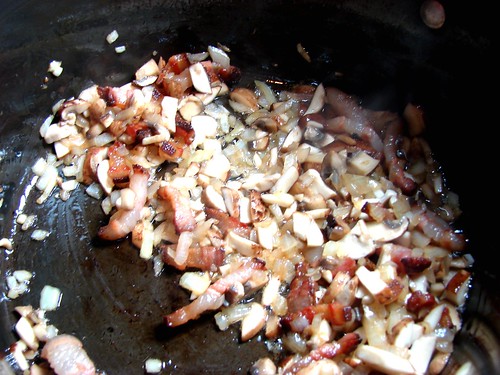
Drain the rice and add to the pan. If necessary, add a bit more olive oil, just enough to coat all the grains. Add 2 tbsps of the chile puree, 6 cps of the seafood broth and adjust the seasoning by adding sea salt as necessary. Lower the temperature to medium-low and allow it to simmer until the broth evaporates. Stir it every so often to make sure nothing gets stuck to the bottom of the pan.

While the rice is cooking, prepare the seafood: chop the shrimp and scallops to bite sizes (remember to save a few of each for plating). Marinate all the seafood (including those for plating) with 2 tbsps of the chile puree and a bit of sea salt and black pepper; set aside until needed.
Once the broth has evaporated, check the doneness of the rice grains. They should be fully open and swollen. If the liquid has evaporated completely, add a bit more broth or water, then add the chopped seafood. Stir in the seafood, bring the temperature to low and allowing to cook covered for another 5 minutes.

In the meantime, saute the reserved shrimp in a bit of olive oil, set aside. When ready to serve, spoon some guacho on the bottom of a bowl, top generously with a couple tbsps of sofrito and top with the sautéed seafood. Enjoy and Buen Provecho!

For the rest of the yummy guacho shots, follow this link. You can also see  the other dish, Langostinos en Caramelo de Maracuyá (Prawns in Passion Fruit Caramel) by following this link. And don’t miss the entries submitted by other food bloggers, visit Foodalogue for the tasty bits.
the other dish, Langostinos en Caramelo de Maracuyá (Prawns in Passion Fruit Caramel) by following this link. And don’t miss the entries submitted by other food bloggers, visit Foodalogue for the tasty bits.
Cookingly yours,
Anamaris
 I made this awesome dish as my contribution to Foodalogue’s Culinary Tour as she takes us and her readers to my homeland, Panama! The criteria to participate in the tour is pretty relaxed, you can either prepare a traditional dish in a) a traditional way, b) traditional dish modernized or c) just implement local ingredients and/or techniques. This particular recipe is one of 2 I shared and it showcases local ingredients in a modern or contemporary way, the other was an almost traditional Seafood Guacho.
I made this awesome dish as my contribution to Foodalogue’s Culinary Tour as she takes us and her readers to my homeland, Panama! The criteria to participate in the tour is pretty relaxed, you can either prepare a traditional dish in a) a traditional way, b) traditional dish modernized or c) just implement local ingredients and/or techniques. This particular recipe is one of 2 I shared and it showcases local ingredients in a modern or contemporary way, the other was an almost traditional Seafood Guacho.
The recipe comes from a beautiful cookbook I picked up on my last trip to Panama. ‘Sabores de Panamá‘ (Flavors of Panama) by Jorge Jurado, one of Panama’s renown chefs who has tasked himself with bringing traditional Panamanian dishes to the next level. The recipe showcases popular local ingredients: shrimp, passion fruit, chayote squash, coconut and sugar cane, these are then elevated when combined with fish sauce and smoked paprika and a beautiful presentation.
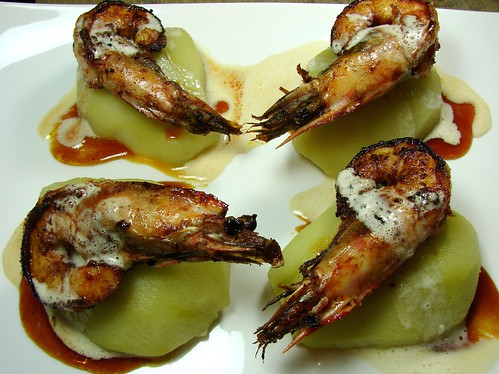
Let’s talk about the ingredients, shall we? Panama is all about the seafood, man. So much so that it is sold door-to-door. Yep, you read right. A few years ago, my dear friend Dorothy went to Panama with me and we stayed at my parents’ home. One morning while we were starting to wake up, we heard a man’s voice over a loudspeaker saying ‘Pescao, pescao, pargo, corvina, cojinoa, PESCAO’. A wave of giggles ensued, she looked at me awestruck. I had mentioned this phenomena to her, but I think she secretly doubted my honesty. See, about 3 times a week, there’s a guy in a truck who drives around my parents’ hood selling the morning catches, it doesn’t get any fresher than that. We didn’t have the ice cream truck, we get the seafood truck.
OK, back to the components of this magical dish. Chayote is a variety of squash that is as readily available in Panamá as zucchini and yellow squash is in the US. Like zucchini, it is very light, has a great deal of water content and a very mild taste with a discernible sweetness. A tart and luscious caramel made of raspadura, unrefined sugar cane, and passion fruit works beautifully with the mild flavors of the chayote and the spiciness of the smoked paprika and habanero pepper and the creamy coconut sauce. I fell in love with this dish, I think you will too.
Langostinos con Caramelo de Maracuya, Chayote y Aire de Coco (Prawns with Passion Fruit Caramel, Chayote and Coconut Foam)

For the prawns:
20 head-on large prawns, peeled & deveined
1 tbsp Spanish paprika
1 tbsp brown sugar
1 garlic clove, crushed
Sea salt & black pepper
Mix the ingredients together and use to marinate the prawns. Allow them to marinate while you prepare the rest of the components.
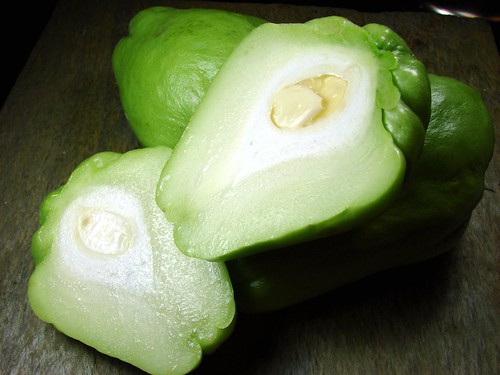
For the chayote:
4 chayote squash, halved
4 rosemary sprigs
Sea salt & black pepper
The recipe suggested peeling the chayotes and cooking in the microwave with a bit of olive oil. I don’t like handling raw chayotes, they have a sticky sap that is a pain to remove from your hands. Instead, I placed them in a pot over a steam tray, added water to the bottom, sprinkled salt & pepper over them and tucked the rosemary sprigs around them. They steamed for about 10-15 minutes and I peeled them just before serving. Easy breezy.
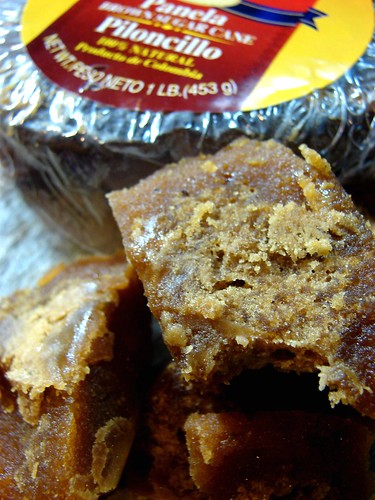
For the passion fruit caramel:
1/2 cp raspadura, crumbled
4 tbsp unsalted butter
1/2 cp passion fruit concentrate
If you cannot find raspadura, you can substitute with dark brown sugar. Melt the raspadura in a small pan and allow it to cook until it becomes caramel. Add the butter and passion fruit concentrate and cook until it thickens again, about 15 minutes. Set aside.
For the coconut foam:
1 cp unsweetened coconut milk
1 tbsp fish sauce
1 tsp fresh ginger, crushed
1/2 tsp habanero paste
1/4 tsp soy sauce
Combine all the ingredients into a small pan and bring to a boil. I didn’t end up with foam, he suggests using a hand blender, which I do not own, so I put mine into the blender. If you do own a hand blender, then keep this warm and use the blender to froth it just as you are finished plating. If you don’t, I suggest cooking down the sauce a bit, to reduce and thicken it, then you can spoon it right over the prawns.
Putting it together:
Heat a skillet and add a bit of olive oil and butter, saute the prawns, cooking for a couple of minutes on both sides (if you’re not a fan of foods with a face, feel free to remove the heads, but there is a lot of flavor there). Set aside, but keep warm.

On a plate, spread about 1 tbsp of the caramel, top with the chayote, then place a prawn atop the squash. Top witht he coconut foam or cream and be ready to ooooh and aaaah in enjoyment.
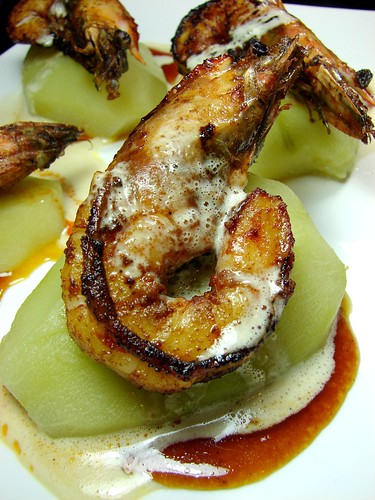
I can’t wait to make this again. Do stop by and take in Joan’s tour. For more shrimpy shots, click here and go here to see my second dish, Guacho de Mariscos y Hongos.
Cookingly yours,
Anamaris
The first time I came across Joan’s blog, Foodalogue, was because of her Culinary Tour events. She chooses a country and invites her readers on a  virtual tour of that country and its cuisine. Joan’s rules for her tour are very relaxed; one can make a traditional dish in a traditional way, OR modernize a traditional dish, OR utilize the ingredients and/or techniques of the country in your own way. The world tour will end this year visiting 7 new countries and Panama will be kicking things off.
virtual tour of that country and its cuisine. Joan’s rules for her tour are very relaxed; one can make a traditional dish in a traditional way, OR modernize a traditional dish, OR utilize the ingredients and/or techniques of the country in your own way. The world tour will end this year visiting 7 new countries and Panama will be kicking things off.
As a 100% Panameña (that’s Panamanian for non-Spanish speakers), I am required to participate and represent. Really, it’s in the constitution or something. When most people think of Panama, they think of the Panama Canal and Noriega, so before we dive into the grub, let me share some so facts regarding my homeland.
- Our borders are the Caribbean Sea, the Pacific Ocean, Colombia and Costa Rica.
- According to the 2010 country rankings by the World Economic Council of Global Competitiveness, Panama ranks 53 out of 139 countries and is expected to end up in the top 50 this year.
- As of 2010 it is the second most competitive economy in Latin America.
- Panama has the largest rainforest in the Western Hemisphere outside the Amazon.
- Basketball is big there and a number of well-known NBA players hail from the little country, including Rolando Blackman (four-time NBA All-Star) and Kevin Daley of the Harlem Globetrotters.
- Another big game, baseball. Rod Carew and Mariano Rivera both hit balls in Panama before hitting the big time.
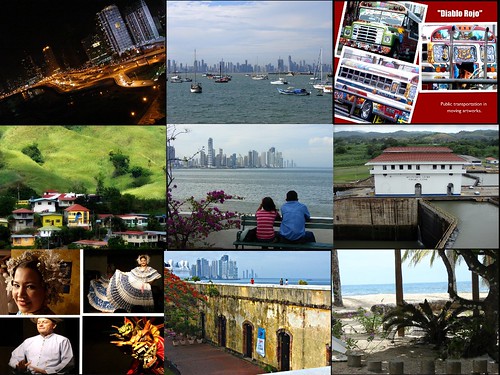
- Panama’s cuisine is influenced by its diverse population of Hispanic, native Indian, European, African and even Chinese migrations.
- Unlike many of the neighboring countries, Panamanian food is not particularly spicy (heat).
- Yellow corn is often used for many of our dishes and fish, seafood and shellfish dishes are Panamanian specialties. For more detailed food info, check this link.

Anydoo, this past year I’ve shared many recipes and told you about foods from Panama and you can be assured that there are plenty more to come starting with 2 dishes I submitted for Joan’s tour. The first is a modern rendition using local ingredients, which could work as a beautiful appetizer, though The Hubbz and I scarfed it down as our entrée the other night. The second came as a result of one of our ‘What’s in the Bag‘ evenings. The Hubbz went to the store and brought everything but the butcher’s block, which I then had to incorporate into a meal. It is a pretty traditional dish, with a very tiny itsy bitsy twist. Ready? Here we go.
For an appetizer: Langostinos en Caramelo de Maracuyá con Aire de Coco (Prawns in Passion Fruit Caramel and Coconut Foam).

This was incredible with an exciting and complex flavor profile. I followed a recipe from Jorge Jurado’s latest cookbook ‘Sabores de Panamá‘ (Flavors of Panama). Jurado is a renown chef in Panama, who is at the forefront of a movement to elevate Panamanian dishes to haute cuisine.
In this recipe, Jurado makes use of popular local flavors: shrimp, passion fruit, chayote squash, coconut and sugar cane and hypes them up with fish sauce and smoked paprika. The final dish is assembled a layer at a time and topped with coconut foam–which I wasn’t able to accomplish, but still ended up with an insanely delicious sauce that tasted of the sea and tropical fruits. That sauce alone would make a dish unforgettable.
This dish wasn’t complicated to put together, but it does have a lot of steps. Because I usually offer step-by-step photo instructions for my dishes, I’ll limit this post to a review and description then direct you here for the how-to.
As an entrée, I offer you a semi-traditional Guacho de Mariscos y Hongos

Guacho (pronounced WAH-cho) is a sort of risotto that is topped with a flavorful sofrito. The primary, always present, ingredients in any guacho are rice and the sofrito that crowns it. Secondary and tertiary ingredients would include an assortment of any of these: various beans, pork, chicken, cured pig’s tails, seafood, and roots such as yuca and otoe.
Panamanian sofrito is generally made with onions, bell peppers, tomatoes, garlic and a few other aromatics, but this time, I added a puree made from dried chile ancho and guajillos. Also, mushrooms are not traditionally added to this dish.
For the guacho, I made a seafood broth with the shrimp skins and used it as cooking liquid for the rice which cooks until swollen plump. The seafood is added just at the end to prevent overcooking. Let me tell you, this is seafood heaven. The rice is laden with seafood and bacon flavors and is complimented by the sweetness of the shrimp and scallops. To add some textural interest, I pan-fried a few of the shrimp & scallops to top each serving. You can check out this post for the step by step recipe.
There you have it! Panamá en tu plato (Panama on your plate). Next stop… ALASKA!
Cookingly yours,
Anamaris
What I saw.


